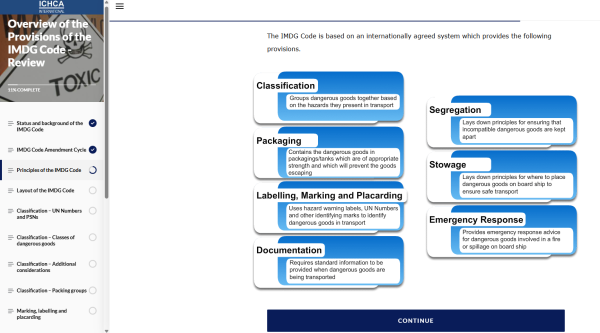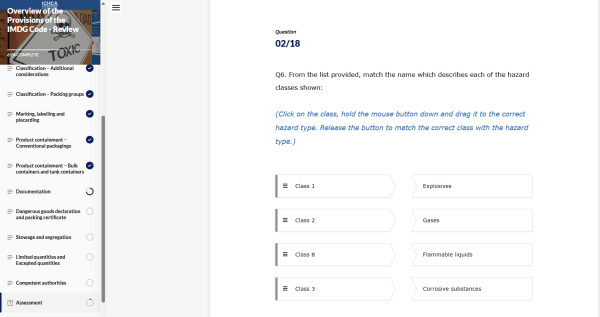Just Launched: Online Course on the IMDG Code (Amendment 42-24)
Helping you to understand the principles of dangerous goods transport by sea
Our Overview of the Provisions in the IMDG Code (Amendment 42-24) – is a self-paced, introductory, online course designed for anyone involved in transporting dangerous goods by sea. This course will help you to understand topics such as how substances are assigned to different classes of Dangerous Goods, what those classes cover and how they can affect different types of marking, labelling and placarding, segregation, stowage and transport.
Updated in line with Amendment 42-24 of the IMDG Code (effective 2026), this course gives you an important introduction to dangerous goods and can support your operations safety.
Who Should Take This Course:
- Cargo handlers and port operators
- Shippers and freight forwarders
- Maritime and logistics professionals
- Regulatory and compliance personnel
What You’ll Learn:
- the IMDG Code’s legal framework and structure
- how dangerous goods are correctly classified
- the function of UN Numbers & Proper Shipping Names
- how marking, labelling, placarding, and documentation requirements are applied
- best practices for stowage, segregation, and limited/excepted quantities
- the role of competent authorities in compliance
Why Choose This Course:
- Up to date: Covers the latest IMDG Code Amendment 42-24
- Flexible: 100% online, self-paced
- Practical: Real-world examples, interactive learning, and assessments
- Certified: Receive a certificate upon successful completion
Course Fees
- ICHCA members GBP 25
- Non ICHCA members GBP 45
Enrol Today
by e-mailing services@hazcheck.com to enquire about delegate places. Please put Overview of the Provisions in the IMDG Code into the subject line and don’t forget to mention ICHCA if you are a member!
Course Content
- Status and background of the IMDG Code
- IMDG Code Amendment Cycle
- Principles of the IMDG Code
- Layout of the IMDG Code
- Classification – UN Numbers and PSNs
- Classification – Classes of dangerous goods
- Classification – Additional considerations
- Classification – Packing groups
- Marking, labelling and placarding
- Product containment – Conventional packagings
- Product containment – Bulk containers and tank containers
- Documentation
- Dangerous goods declaration and packing certificate
- Stowage and segregation
- Limited quantities and Excepted quantities
- Competent authorities
- End of course test
Need more detailed or hands-on training?
We recommend the full IMDG Code training from our members, NCB Hazcheck. Learn more about IMDG Training.




